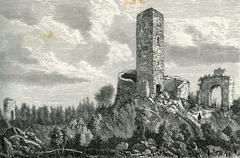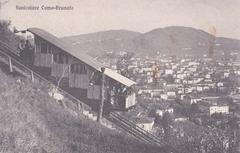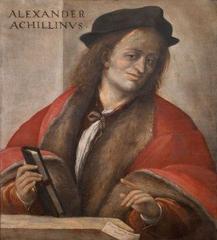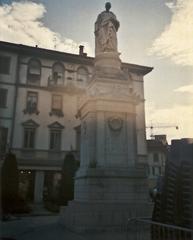
Como–Fino–Saronno Tramway: Visiting Hours, Tickets, and History Guide
Date: 04/07/2025
Introduction
The Como–Fino–Saronno Tramway is a cornerstone of northern Italy’s industrial and transportation legacy. Established during the late 19th-century industrial boom, the tramway linked Como, Fino Mornasco, and Saronno, propelling economic growth and urban development throughout Lombardy. Though the original tramway ceased operation in the mid-20th century, its legacy survives through preserved infrastructure, museums, and active cultural organizations. Today, the former route serves as a scenic pathway for walking and cycling and offers travelers a unique vantage point into the region’s transformation.
This guide provides a comprehensive overview of the tramway’s history, visiting hours, ticketing options, and practical travel tips, ensuring visitors have all the information needed for an enriching experience. For those eager to explore the region, current transportation alternatives, like the R17 regional rail service, offer convenient access along the tramway’s historical corridor (Trenord). Whether you’re a history buff, a casual traveler, or a local resident, the Como–Fino–Saronno Tramway offers a journey through time set against the picturesque backdrop of Lake Como.
Discovering the Como–Fino–Saronno Tramway
Historical Overview
Launched in the late 19th century, the Como–Fino–Saronno Tramway was conceived as a crucial regional connector, driven by visionaries like Felice Rodriguez and Angelo Minoretti. Initially operating with steam-powered trams before transitioning to modern railway technology in 1898, the line catalyzed regional development by linking commercial, industrial, and residential centers. The tramway not only facilitated the transport of goods and people but also played a formative role in shaping urban landscapes and fostering social integration.
What Remains Today
Although trams no longer run, the tramway’s heritage is preserved in several ways:
- Walking and Cycling Paths: The original tramway route, such as along Viale Prealpi in Saronno, has been transformed into accessible paths for pedestrians and cyclists.
- Historic Stations and Bridges: Sites like Fino Mornasco Station and Cadorago’s old tramway bridge serve as tangible reminders, with interpretive signs and preserved architecture.
- Museums and Cultural Associations: Museums such as the Museo Ferrovie Nord Milano and Silk Museum in Como display artifacts, photographs, and documents. The Circolo Culturale Saronnese “Il Tramway” actively organizes exhibits and special events (Il Tramway Activities).
Visiting Hours and Ticket Information
Key Sites and Museums
- Museo Ferrovie Nord Milano (FNM):
- Hours: Tuesday–Sunday, 10:00 AM–5:00 PM
- Admission: Tickets required; discounts for students/seniors
- Museo della Seta (Silk Museum), Como:
- Hours: Tuesday–Sunday, 9:00 AM–5:00 PM
- Admission: ~€6, with concessions
- Museo delle Industrie e del Lavoro del Saronnese, Saronno:
- Hours: Wednesday–Sunday, 10:00 AM–6:00 PM
- Admission: ~€5
Open-air heritage sites (paths, bridges, stations) are free and accessible year-round. For guided tours, tickets and schedules are available via local tourist offices or directly through organizations like Il Tramway Activities.
Getting There and Accessibility
- By Train: Regional services (Trenord R17) connect Como, Fino Mornasco, and Saronno efficiently (Trenord).
- By Bus: Local buses supplement train routes.
- Accessibility: Most urban sites are wheelchair-friendly. Rural portions of the path may require sturdy footwear; contact museums or organizers in advance for specific accessibility needs.
Guided Tours and Special Events
Guided tours—often featuring local historians and enthusiasts—are offered seasonally and during heritage festivals. These immersive experiences retrace the tramway’s route, highlight architectural features, and share stories of local life during the tramway era. Special exhibitions and reenactments are periodically organized by groups like Circolo Culturale Saronnese “Il Tramway” (Il Tramway Activities). Check official tourism portals for current schedules.
Practical Travel Tips
- Best Times to Visit: Spring and autumn offer pleasant weather and coincide with local cultural festivals.
- Tickets: Purchase museum and guided tour tickets in advance during peak periods.
- Public Transport: Consider multi-modal tickets for seamless travel around Lake Como (Trenord).
- Cycling: Many sections of the old tramway route are bike-friendly; trains allow bicycles for a supplement.
- Luggage and Comfort: Major stations offer storage and amenities; travel mid-morning or early afternoon for less crowded journeys.
Nearby Attractions
- Como Old Town: Explore the Duomo, Broletto, and lakeside promenade (Lake Como Travel).
- Brunate Funicular: Panoramic views over Lake Como (Full Suitcase).
- Saronno: Visit the Sanctuary of the Blessed Virgin of the Miracles and sample local amaretti (Visit Italy).
- Lake Como Ferries: Connect to Bellagio, Varenna, and other picturesque towns.
Historical and Cultural Significance
The tramway’s role extended beyond transport. It spurred urbanization, supported the flourishing silk industry (Life in Italy), and fostered social and cultural exchange. Its integration of new technologies set standards for future infrastructure. Preservation efforts by organizations like Circolo Culturale Saronnese “Il Tramway” keep the memory alive, engaging the community through exhibitions, educational programs, and special events (Il Tramway Activities).
Frequently Asked Questions
Q: Are there still operational trams?
A: No, the original tramway is no longer operational. The route is now served by modern trains and is marked by preserved heritage sites.
Q: Where can I buy tickets for museums or tours?
A: Tickets are available at museum entrances, online, or via local tourist offices. Guided tour bookings can be made through Il Tramway Activities.
Q: Is the tramway route suitable for families?
A: Yes, the mostly flat and accessible paths are family-friendly.
Q: Are the museums and stations accessible?
A: Most sites are wheelchair-accessible. Contact venues in advance for specific needs.
Summary Table: Key Visitor Tips
| Aspect | Details |
|---|---|
| Museum Entry | €5–€6, with discounts; open-air sites free |
| Train Frequency | Every 30–60 minutes (Trenord R17) |
| Accessibility | Most stations, museums, and urban routes accessible |
| Guided Tours | Seasonal, book via local offices or Il Tramway Activities |
| Cycling Policy | Bikes allowed on trains with supplement |
| Best Time to Visit | Spring or autumn |
| Local Highlights | Como Cathedral, Brunate Funicular, Saronno Sanctuary |
| Official Info | VisitComo.eu, Trenord |
Plan Your Visit
Embrace the opportunity to explore the Como–Fino–Saronno Tramway—an emblem of Lombardy’s progress and community spirit. Utilize resources like the Audiala app for interactive maps and audio guides, and stay updated on cultural events via official tourism platforms (VisitComo.eu, Il Tramway Activities).
Sources and Further Reading
- Il Tramway Activities
- Trenord – Como–Saronno–Milano Regional Line (R17)
- VisitComo.eu Official Tourism Portal
- Museo della Seta - Silk Museum
- Museo delle Industrie e del Lavoro del Saronnese
- Full Suitcase – Best Things to Do in Como
- Lake Como Travel
- Visit Italy – Saronno
- Life in Italy – History of Como and Its Lake
- Savoring Italy Lake Como Travel Guide







